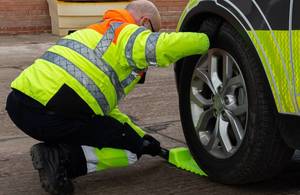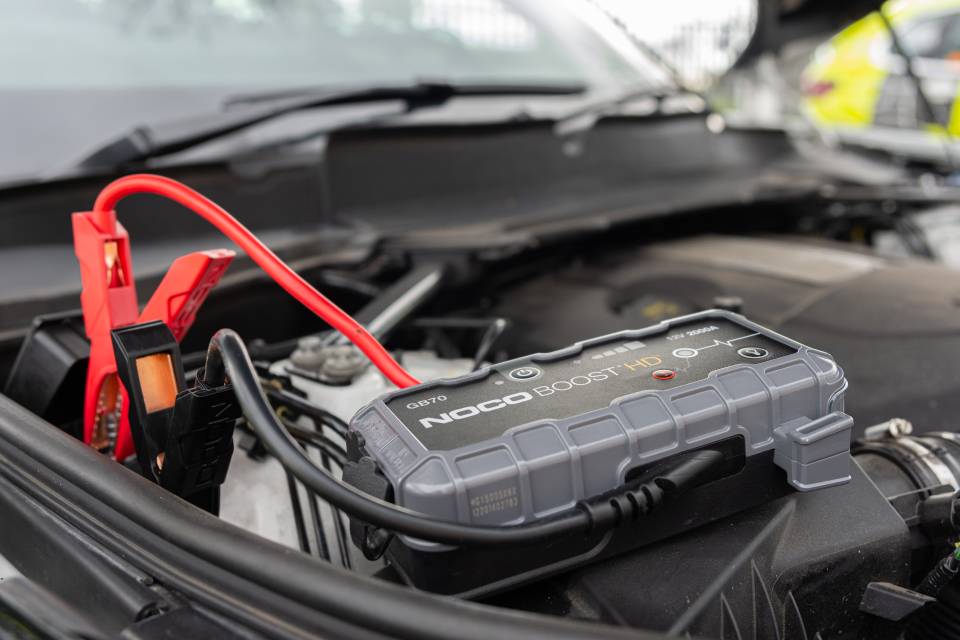Vital equipment helps slash time taken to move stranded vehicles to safety
Every traffic officer vehicle is now equipped with plastic skates and battery boosters to move broken down vehicles to safety quicker

National Highways Traffic Officer demonstrates how the skates, also known as Slippery Jims, work
New gadgets have been introduced to help slash the time taken to move a stranded vehicle out of a live line to safety on motorways or major A roads.
National Highways has invested ¬£200,000 in new equipment and training for all Traffic Officers to help speed up the time it takes to move 바카라 사이트únon-rolling바카라 사이트Ě broken down vehicles 바카라 사이트ď including electric vehicles 바카라 사이트ď to a safe place and keep traffic moving.
As part of the change, all 262 National Highways traffic officer vehicles have been equipped with plastic skates, with training also provided to all Traffic Officers across the country in how to use them. The skates, also known as 바카라 사이트úSlippery Jims바카라 사이트Ě, work by being hammered under each tyre. This helps to reduce the surface friction between tyre and road, allowing it to be towed to a place of safety by a National Highways Traffic Officer vehicle.
They can be used to safely move depleted electric vehicles (EVs). Towing an EV can greatly damage the vehicle due to how the motors are attached to the wheels and their lack of a true neutral gear. Where previously traffic officers had to wait for a recovery vehicle to avoid damaging the vehicle further, EVs can now be moved right away with the use of this new equipment.
Additionally, Traffic Officer vehicles have also been fitted with 바카라 사이트úbattery boosters바카라 사이트Ě 바카라 사이트ď an effective tool to combat a battery failure on a combustion engine vehicle. The booster will help jump start the battery of any vehicle (up to 8 litre petrol and 6 litre diesel) immediately, allowing it to be moved to a safer area.

The battery booster in action providing a jump start to a broken-down vehicle
The announcement of the new kit was made as National Highways launched the latest phase of its 바카라 사이트úGo Left바카라 사이트Ě campaign today to advise drivers who experience a problem with their vehicle.
Mel Clarke, National Highways Customer Service Director, said:
No-one plans to break down, but if the unexpected happens the new equipment we have fitted to all our vehicles will further reduce the time it takes to move a stranded vehicle out of a live lane to a safer area, reducing the risk to both our Traffic Officers and other road users.
The new apparatus allows our Traffic Officers to be much more agile when dealing with broken down vehicles. Beforehand we바카라 사이트ôd have to wait for a recovery vehicle to get to the scene but this new approach speeds up clearance times, further improves motorway and major A road safety and allows carriageways to return to normal running quicker.
This is one of a number of measures being introduced to support the shift to zero emissions journeys to meet the governments바카라 사이트ô 2050 net zero carbon target.
The kit was rolled out nationwide last year following a successful trial in the East of England. The trial proved that the plastic skates were 100% successful in towing a non-rolling vehicle to safety, while the battery boosters were 99% effective in providing power.
Dave Harford, National Highways Traffic Officer, said:
Safety is one of National Highways top priorities, and when we바카라 사이트ôre dealing with a non-rolling vehicle in a live lane of a motorway or major A road our primary concern is finding a way to move the vehicle to an area of safety as quick as possible whilst minimising risk.
This new equipment is a great addition to our vehicles as we바카라 사이트ôre able to safely move vehicles much more effectively, which gets the recovery process moving much faster helping to minimise any delays to other road users.
In 2021 there were almost 205,663 reported breakdowns across the National Highways network including around 183,453 on motorways.
Before the introduction of the new skates and battery boosters, it could be the case that where a non-rolling electric vehicle was concerned a Traffic Officer would need to wait for vehicle recovery. During this time the stranded vehicle can cause delays to other drivers. It바카라 사이트ôs expected that removing incidents from live lanes more quickly will equate to a minimum boost of ¬£29.8m per year to the UK economy.
As part of the 바카라 사이트úGo Left바카라 사이트Ě campaign, motorists in difficulty are recommended to leave the motorway if possible and if this is not possible:
Go left
Put your left indicator on and move into an emergency area, onto a hard shoulder, motorway service area, left-hand verge or A-road lay-by.바카라 사이트Į
Switch your hazard warning lights on, even during the day. If it바카라 사이트ôs dark, use side lights and in poor visibility use fog lights as well.
On a motorway without a hard shoulder, it should be possible for most vehicles experiencing a problem to reach an emergency area. These are regularly spaced and are marked by a clearly visible orange road surface and blue signs featuring an orange SOS telephone symbol.
Get safe바카라 사이트Į
If it is safe to do so, and you can get out with any passengers, exit your vehicle on the side furthest from traffic. If it is not safe to do so, stay in your vehicle and wait for help.
Keep well away from moving traffic and your own vehicle. Get behind a safety barrier where there is one, and where it is safe to do so. If you바카라 사이트ôre on a verge, be aware of any unseen hazards such as uneven ground or debris.바카라 사이트Į
Get help
Contact National Highways on 0300 123 5000 and then a breakdown recovery provider.바카라 사이트Į
If you are unable to exit your vehicle and get to a safe place, have stopped in a live traffic lane or feel your life is in danger, stay in your vehicle with your seatbelts and hazard lights on and call 999 immediately.바카라 사이트Į바카라 사이트Į
More advice about .
General enquiries
Members of the public should contact the National Highways customer contact centre on 0300 123 5000.
Media enquiries
Journalists should contact the National Highways press office on 0844 693 1448 and use the menu to speak to the most appropriate press officer.